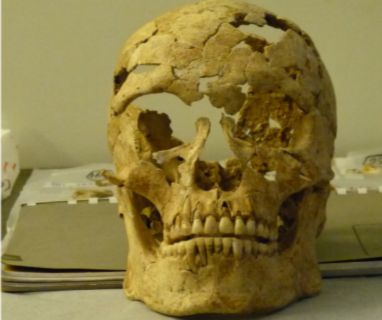Ancient human skeleton reveals 12,000-year-old conflict in southeast Asia
Hunter-gatherers from 12,000 years ago used quartz-tipped weapons against each other, scientists have discovered.

Experts were working in a cave in northern Vietnam when they unearthed the 12,000-year-old remains of a man shot by an arrow with an exotic stone tip.
The international-Vietnamese team was led by Dr Ryan Rabett, who is Project Director of (SUNDASIA), an Honorary Senior Lecturer in Human Palaeoecology at Queen’s University Belfast and Visting Fellow at The American College of Greece.

Reconstruction and analysis of the skeleton has revealed that the man was around 35 years old at death. Genetic evidence demonstrates that the individual belonged to an early indigenous hunter-gatherer population.
Dr Rabett says: “It’s like opening a time capsule. There’s a real sense of direct connection to the final painful weeks of this one individual’s life; and a powerful reminder that the sweep of prehistory was made up of lived moments, so often lost to us.”
The findings have been published in the journal Proceedings of the Royal Society B: Biological Sciences. The paper’s lead author is Dr Chris Stimpson from the Oxford University Museum of Natural History/Natural History Museum UK.
Sharp implement
It appears that a sharp implement pierced his neck with sufficient force to fracture a cervical rib. The culprit, a quartz point, was found in association with the injured bone, but this artifact presents something of a mystery.
“The point is especially intriguing,” said lithic specialist, and co-author, Dr Benjamin Utting of the Smithsonian National Museum of Natural History.
“It doesn’t match any other stone tools from Thung Binh 1 or nearby sites, raising questions about who made it and where it came from.”
The injury was not immediately fatal. Instead, the damaged bone indicated a likely death from infection, over weeks or months.
Extremely rare
Dr Alex Wilshaw, a forensic anthropologist from Liverpool John Moores and second author on the paper, explains: “This individual must have initially been in very good health to have survived so long with this injury, there must have been people caring for him, bringing food and sheltering him."
He says: “The injury and infection would have been debilitating and he would have been in an incredible amount of pain for a long time before his eventual death.”
The finding is extremely rare; there are very few skeletons of this age in existence right across the world.
Significant discovery
To mark the significance of the discovery and the world-wide media attention it has received, provincial authorities and local stakeholders in Vietnam arranged a press conference to coincide with World Tourism Day on 27 September.
The conference was attended by more than 2,000 delegates and covered on prime-time national TV in Vietnam.
Three of the authors, including Dr Rabett, were guest speakers. Dr Rabett delivered a presentation about the archaeological research that gave rise to the find.
He also emphasised that custodianship of Tràng An’s cultural and natural heritage and the pride to be felt in its outstanding values belongs to the people of Tràng An.
He comments: “In Vietnam, the discovery has inspired another narrative besides the evidence of ancient conflict. Here, the find also draws on traditional references to the honourable warrior and to the sacrifice of his life to injury."
He adds: “During the conference, both the scientific detail and the cultural importance of this discovery were acknowledged, and special recognition was given to the collaborative teamwork that lay behind bringing this exceptional and hidden story to light.”
Media
Media enquiries to emma.gallagher@qub.ac.uk